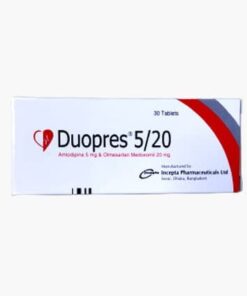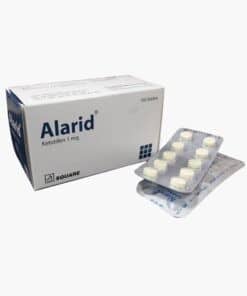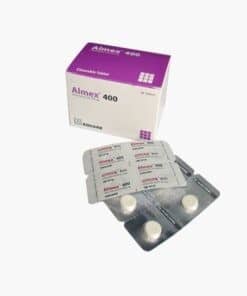Paloxi | 0.5 mg | Tablet | 10 pcs
৳ 220.00
Brand Name: Paloxi Tablet
Generic: Palonosetron
0.5 mg
Manufacturer: Beacon Pharmaceuticals Ltd.
Unit Price: ৳ 22.00 (2 x 10: ৳ 440.00)
Strip Price: ৳ 220.00
Indications
Palonosetron indicated in-
- Acute and delayed nausea and vomiting
- Uncontrolled nausea and vomiting
- Chemotherapy-induced nausea and vomiting (CINV): Acute CINV resulting in on the day of treatment with certain types of chemotherapy
- Delayed CINV resulting in on days later with certain types of chemotherapy
- Radiotherapy-induced nausea and vomiting (RINV)
- Post-operative & Post-discharge nausea and vomiting (PONV & PDNV).
Pharmacology
Palonosetron is a 5-HT3 receptor antagonist with a strong binding affinity for this receptor and little or no affinity for other receptors. It is thought that chemotherapeutic agents produce nausea and vomiting by releasing serotonin from the enterochromaffin cells of the small intestine and that the released serotonin then activates 5-HT3 receptors that are located on the nerve terminals of the vagus in the periphery and centrally in the chemoreceptor trigger zone of the area postrema, to initiate the vomiting reflex. Postoperative nausea and vomiting is influenced by multiple patient, surgical and anesthesia related factorcs and is triggered by release of 5-HT3 in a cascade of neuronal event involving both the central nervous system and the gastrointestinal tract. The 5-HT3 receptor has been demonstrated to selectively participate in the emetic response. Palonosetron works by blocking the actions of Serotonin, associated with nausea and vomiting, at 5-HTs receptor. It is likely that Palonosetron works in the small intestine but it may also work in the brain.
Pharmacokinetics: Palonosetron exhibits linear dose-proportional pharmacokinetics over the doserange 1-90 pg/kg in healthy subjects and in patients with cancer. In cancer patients receiving single intravenous doses of Palonosetron in this dose range, the mean maximum plasma concentration (Cmax) ranges from 0.89 to 336 ng/ml and the area under the plasma concentration-time curve from zero to infinity (AUCo-co) ranges from 13.8 to 957 ng.h/ml. Palonosetron has a volume of distribution of approximately 6.9-7.9 L/kg, with approximately 62% bound to plasma proteins. Approximately 50% of Palonosetron is metabolized into two inactive metabolites that exhibit <1% of the 5-HT3 receptor antagonist activity. Approximately 40% of the drug is metabolised via kidney, 50% by liver CYP2D6 (mainly), CYP3A4 and CYP1A2 isoenzymes. About 50% of the drug goes under metabolism. After a single intravenous dose, approximately 40% is excreted as unchanged drug in the urine after 144 hours. Total body clearance of Palonosetron is 160±35 ml/h/kg, and renal clearance is 66.5±18.2 ml/h/kg in healthy subjects. Palonosetron exhibits a longer half-life (40 hours) and has a greater 5-HT3 receptor binding affinity.
Dosage & Administration
Usual dosage: Adult tablet dosage: 0.5 mg daily. Adult IV dosage: A single IV dose of 0.075 mg should be administered over 10 seconds.
Chemotherapy-induced nausea and vomiting: Adult tablet dosage: 0.5 mg administered approximately 1 hour prior to the start of chemotherapy. Adult IV dosage: A single IV dose of 0.25 mg should be administered over 30 seconds approximately 30 minutes before the start of chemotherapy.
Radiotherapy-induced nausea and vomiting: A single IV dose of 0.25 mg should be administered over 30 seconds approximately 30 minutes before each week of radiation fraction.
Post-operative nausea and vomiting: A single IV dose of 0.075 mg should be administered over 10 seconds immediately before induction of anesthesia.
Children dosage: (1 month to 17 years): A single IV dose at 20 mcg/kg body weight. Which maximum dose is 1.5 mg.
Interaction
Contraindications
Side Effects
Pregnancy & Lactation
Use in Special Populations
Use in elderly patients: No dosage adjustment is recommended in elderly patients >65 years of age.
Use in Children: (1 month to 10 years): A single IV dose at 20 mcg/kg body weight. Which maximum dose is 1.5 mg.
Use in patients with impaired renal and hepatic function: No dosage adjustment is recommended in patients with renal and hepatic dysfunction.
Overdose Effects
Therapeutic Class
Storage Conditions
| Generic Name | Palonosetron |
|---|---|
| Tablet | 0.5 mg |
Only logged in customers who have purchased this product may leave a review.











Reviews
There are no reviews yet.